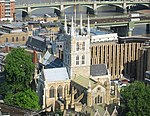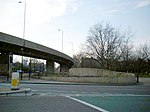Long Lane (Southwark)

Long Lane is a main east–west road in Southwark, south London, England. The south side of the medieval-founded St George the Martyr church, of high classical 1730s design, adjoins the street before its western ending. East of the church is a paved, tree-studded, pedestrianised zone before park St Georges Gardens, the successor to its churchyard. This was the church where Little Dorrit (in Dickens's Little Dorrit) was baptised and married. Dickens in reality lodged one block southwest as a child in Lant Street when his father was in the Marshalsea debtors' prison during 1824. It was a traumatic period of his life. A few metres north of the lane's "London" end (so along Great Dover Street) are steps to Borough tube station. Just before its western end, a T-junction with Great Dover Street, it has the north end of the modernised but medieval route of that street, Tabard Street, which is a Georgian renaming of the London conclusion of the Old Kent Road (its conclusion can otherwise be considered bustling Borough High Street/London Bridge beyond, all piling in the traffic to the city from Surrey and Sussex). A few metres north, Great Dover Street has its final crossroads, crossing Borough High Street to face Marshalsea Road which links to Southwark Bridge Road The road is designated the A2198. At the east end, via Abbey Street is a crossroads, crossing Tower Bridge Road (the A100). Before giving over to Abbey Street most traffic is signposted to and from Bermondsey Street (the A2205) which is further east.
Excerpt from the Wikipedia article Long Lane (Southwark) (License: CC BY-SA 3.0, Authors, Images).Long Lane (Southwark)
Long Lane, London Borough (London Borough of Southwark)
Geographical coordinates (GPS) Address Nearby Places Show on map
Geographical coordinates (GPS)
| Latitude | Longitude |
|---|---|
| N 51.4993 ° | E -0.086 ° |
Address
Taper Building
Long Lane 175
SE1 4PD London, Borough (London Borough of Southwark)
England, United Kingdom
Open on Google Maps










